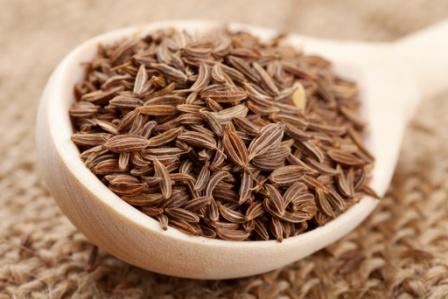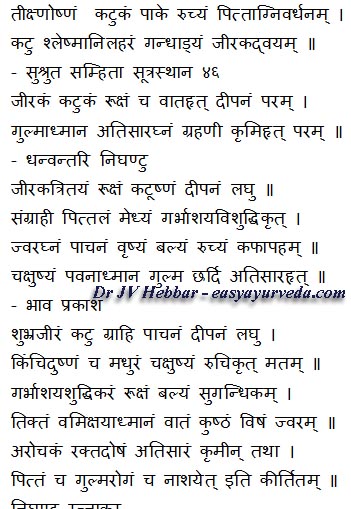Cumin Seed Benefits, Usage, Side Effects, Remedies
Cumin seeds are called Jeeraka in Sanskrit. The word is derived from Jeerna – digestion. Hence Jeeraka means that which digests. Cumin seed is very good in treating digestive tract disorders.
Botanical name – Cuminum cyminum Linn.
Family – Umbelliferae (Satapushpa kula)
Table of Contents
Medicinal qualities
Guna (qualities) – Laghu (light to digest), Rooksha (dry)
Rasa (taste) – Katu (pungent)
Vipaka (taste conversion after digestion) – Katu (pungent)
Veerya (potency) – Ushna (hot)
Effect on Tridosha – Kaphavatahara – balances Kapha and Vata, increases Pitta.
Pharmacological action – Appetizer, Carminative, Blood purifier, Antispasmodic, Anti fungal
Jeera Home Remedies
Flatulence, bloating
1. Fried cumin seeds and ginger powder for flatulence (gas):
4 parts of cumin seeds and 2 part of dry ginger and 1 part of salt (preferably rock salt) are taken and fine powder is made. This is taken in the dose of half spoon just before taking food, along with warm water.

Cumin for digestion
2. Jeera water for indigestion, anorexia and reflux oesophagitis:
20 gram of fried cumin seeds are taken and dry-fried a little.
This is added to 200 ml of hot water and allowed for cooling.
When it is lukewarm this is taken twice daily.
This helps to relieve most of the GIT problems, especially in children.
Jeera for Menstrual pain
3. Cumin jaggery remedy for menstrual pain:
50 gram of Jeera powder is fried in a pan.
It is mixed with 25 gram of jaggery and pounded well.
This is made into big pills of 5 gram size.
This bolus is taken 1-2 days prior to expected date of menstruation.
After taking this, a cup of water or buttermilk can be consumed.
This can be continued even after menstruation for 2-3 days. This helps to reduce the pain and discomfort caused during menstruation.
This remedy can be used as a substitute for Jeeraka rasayana, a classical formulation.
Good appetite, taste and digestion can be expected from this recipe.
So those who have the need to improve digestion strength, can take this recipe irrespective of gender.
Read related: Home Remedy For Flu, Cold, Indigestion [Video]
Fatigue
4. Cumin medicated milk for fatigue and excessive thirst:
5 gram of cumin seeds,
200 ml milk and
400 ml water are taken and boiled till it is reduced to the amount of milk or approximately to 200-250 ml.
To this 1 – 2 teaspoon of sugar or jaggery can also be added.
This is a substitute drink for coffee and tea.
This relieves fatigue and thirst.
This is useful in morning sickness of pregnant mothers as well.
Read related: Ayurvedic Home Remedy To Improve Digestion
Cumin for cough
5. Jeeraka and sugar candy as expectorant – to take out phlegm:
2 grams of each of cumin seeds and sugar candy are taken and retained in the mouth for 3-5 minutes and gradually it is chewed and slowly swallowed.
10-15 minute later gradually phlegm starts coming out and it should be spit out.
This can be repeated 5-6 times in a day.
This is useful in dry cough, pharyngitis, pain in the throat etc
Try any of the above and let us know how you benefited from these remedies.
Click to consult Dr MS Krishnamurthy MD(Ayu), PhD
Other Jeera Remedies
- Cumin powder along with Kala namak (Sochal salt) is used as a remedy to counter side effects of excess intake of sour mango. (Bhava Prakasha). Read more about sour mango benefits
- In fever it is used along with jaggery to improve appetite, cleanse the bowel and relieve burning sensation.
- Cumin is used with curd in diarrhea.
- Cumin along with lime juice is beneficial in vomiting of pitta dosha origin during pregnancy.
- Bathing with decoction of cumin seeds is used to cure itching.

Properties as per Bhojana Kutuhalam
According to Bhojana kutuhalam as mentioned in the section of sambhara, Jeeraka is pungent in taste, hot in potency, improves taste perception, stimulates the digestive fire and promotes digestion, It is fragrant, improves intellect, alleviates kapha dosha, helps in treating vomiting, diarrhea, gulma, colicky pain, any abdominal disorders, intestinal worms and dental problems.
Cumin seed benefits
Ruchya – improves taste
Deepana, Agnivardhana – Improves digestion strength
Grahi, Sangrahi – absorbent, useful in malabsorption syndrome and diarrhea,
Medhya – improves intelligence
Garbhashaya Vishuddhikrut – cleanses and detoxifies the uterus. Hence it is widely used in postpartum care of the mother.
Jvaraghna – Useful in fever
Pachana – carminative
Vrushya – natural aphrodisiac
Balya – improves strength and immunity
Chakshushya – good for eyes, improves vision power
Ruchya – improves taste
Ayurveda explains that cumin has below properties –
Deepana (carminative),
Pachana (digestive),
Vatanulomana (anti flatulent),
Vedanasthapana (analgesic), anti spasmodic
Balya (tonic),
Ruchya (taste enhancer),
Shoolahara(anti colic) etc.
Indications, dose
Jeera is the useful in the treatment of
Gulma – Abdominal tumor, bloating
Adhmana – bloating, gaseous distension of abdomen
Atisara – diarrhea, dysentery
Grahani – malabsorption syndrome
Krumi – worm infestation
Chardi – vomiting
Kshaya – chronic respiratory disorders leading to emaciation
Kushta – skin diseases
Visha – Aconitum ferox poisoning
Jvara – fever
Dose – 3 -6 grams – once or two times a day after food. It can be taken along with hot water or honey or even with ghee.
How to use cumin as per Ayurveda:
Cumin is dry fried on a pan. Only then it is used. If it is not dried, there will be some amount of stickiness to it. Its reference for frying is mentioned in Vaidya yoga ratnavali book, published by impcops.
Cumin according to Dosha
How to take cumin based on your Dosha?
For people with high Vata, Cumin seeds are administered along with sesame oil. It can be fried in sesame oil and taken.
Cumin for Pitta –
Cumin is hot in nature, and so is Pitta Dosha. Hence, you need to take it with coolant and that balances Pitta powerfully. For this purpose, Cumin is fried with ghee or coconut oil for Pitta.
Ghee is said to be the best remedy for Pitta. It counters the gastric irritation effect of Jira Read ghee benefits
Coconut oil, being nourishing and cooling, is very effective in countering the hotness of cumin and Pitta Dosha. Read coconut oil benefits
Cumin for Kapha –
Cumin naturally balances down Kapha Dosha. Hence, dry fried cumin can be readily given to Kapha persons. If you wish to enhance the taste of cumin, then you can administer it along with honey. Of all the liquids for Kapha balance, honey is said to be the best. Read related: Honey benefits
Right way to consume cumin in people of all Doshas
Jira: Interaction with medicines, supplements
Can this be used while taking Homeopathic medicine?
Yes. This product does not react with homeopathic medicine.
Can this medicine be continued while taking supplements like multivitamin tablets, Omega 3 fatty acids etc?
Yes. Generally, this product goes well with most dietary supplements. However, if you are taking more than one product per day, please consult your doctor for an opinion.
With western
medicines
Seek your
doctor’s advice if you are taking this product along with other western
(allopathic / modern) medicines. Some Ayurvedic herbs can interact with modern
medicine.
If both Ayurvedic and allopathic medicines are advised together, then it is
best to take Allopathic medicine first, wait for 30 minutes and then take the
Ayurvedic medicine.
Ayurveda medicines
Hingwastak Churna – useful in indigestion
Dhatri Rasayan – useful in indigestion, cold, cough, asthma etc.
Jeerakarishtam – useful in postnatal care of the mother
Yogaraj Guggul – useful in various joint disorders.
Chemical constituents, nutritional facts
Cumin contains thymol, which helps promote the production of saliva, bile and other enzymes responsible for food digestion. The aromatic compound Cuminaldehyde helps to induce secretion of digestive juices just by the aroma.
Cumin is a rich source of iron.
A spoonful of cumin is useful to reduce body fat and thus useful in weight loss treatment.
Cumin is an anti-congestive agent and is a good expectorant, due to its rich essential oils. Hence useful in cough, cold and bronchitis.
Cumin contains riboflavin, vitamin B6 and niacin – useful in improving cognitive functions of the brain.
Morphology
A slender annual plant
Leaves – 3 partite, ultimately segments are filiform
Inflorescence – Compound umbel, rays are few, has several bracts, petals are white in color, often unequal
Fruits – Cylindric with narrow tip
Useful part – Fruit
Research
Research carried out by the Cancer Research Laboratory in South Carolina, USA, found that cumin can help fight cancer, due to cuminaldehyde, which have been shown to slow the growth of tumors. It also has characteristics that accelerate the production of detoxifying and anti carcinogenic enzymes, which can aid the prevention of colon cancer.(1)
Cumin contains Vitamin E, hence useful to improve skin tone and texture.
Cumin with Coriander seed
Cumin powder and coriander – is a very good combination. It is useful to improve digestion strength but still has a mild coolant effect. This is ideal to improve digestion strength in people with sensitive stomachs, who cannot tolerate hard spices such as ginger or black pepper.
The best way to take it is – Mix them together in equal quantities. Take a teaspoon of it, soak in water at night. Filter and drink it the next morning, on an empty stomach.
Systemic Action (Sthanika Karma)
External – Analgesic, Anti inflammatory, and scraping action on dhatus. Its decoction can be useful in itchy types of skin lesions. Its paste is beneficial in Hemorrhoids, Scorpion bites. Powder can be used as Anjana in Eye disorders.
Digestive System – Appetizer, increases digestive fire, Antispasmodic, facilitates movement of vata dosha in normal direction, Absorbent, Anthelmintic. Indicated in loss of appetite, anorexia, Constipation, Colic pain, Malabsorption syndrome, indigestion, helminthiasis.
Circulatory System – Good for Heart, Indicated in various blood borne diseases. Stimulant.Excretory System – Induce urine production. In conditions like Dysuria, Urinary tract infection, Renal calculi jeera powder can be administered along with sugar.
Reproductive System – Aphrodisiac. Indicated in Leucorrhea. To improve breast milk production after delivery it can be administered along with Jaggery. It is an important medicine in post delivery care as it constricts the uterine muscles and helps to expel out the doshas.
Skin – it is indicated in skin disorders.
Satmikarana – Helps to regain body strength. Improve digestion and absorption.
Tapakrama – Indicated in chronic / acute fever
Vernacular names
Bengali name – Jeera, Sadajeere, Shahajeere, Jeere
Hindi name: Safed Jeera, Jeera, Sada jeera, Sadarana jeera
Marathi name – Jire, Pandare jeere
Gujarati name – Jeeru, Shakanu jeerum, Sadu jeerum, Gholu jeerum
Tamil name – Cheerakam, Shiragam,
Telugu name – Jeelakari, Jelakara, Jeela karara
Kannada name – jeerige
Malayalam name – Jeerakam
Arabbain name – kammun, Avyaja
Farsi name – Jeera e safed
Sanskrit synonyms
Jeeraka –
Ajaji – Cumin – Cuminum cyminum,
Jarana – Good digestant
medhyam – Improves memory
Ruchyam – Improve taste
Pitabham – Fruit is yellowish in color
Dirghakam – Fruit if Jiraka is long
Classical categorization:
Charaka Samhita – Shoolaprashamana – herbs that relieve abdominal pain
Sushruta and Vagbhata – Pippalyadi group of herbs
Distribution: It is widely cultivated across India.
Varieties
Bh P Ni – Jiraka, Krishna Jiraka, Kalajaji
Dh. Ni – Jiraka, Sukla Jiraka, Krishna Jiraka, Brihatpali











28 comments
Amita
Thanks Doctor for the useful info
We normally use Jeera in dal everyday (fry with Ghee) .. Is there some other way we can use it for indigestion ?
Dr J V Hebbar MD(Ayu)Author
Hi, any one way of using is just fine.
Sujaya ranganath
please write something about black jeera and its uses
Sujaya
Dr J V Hebbar MD(Ayu)Author
Hi, I will cover it soon. regards
Ravi
Respected sir,
Mostly I have found online that CUMIN is advisable for PITTA people.http://www.aayushanti.com/index.php/diet/pitta-diet
I am a pitta person and to me it tastes bitter and certainly not pungent. Does it really increase PITTA ?
Dr J V Hebbar MD(Ayu)Author
Hi, as you can see in the verse section, all the ancient Authors concur that it is hot in nature, and has digestive and carminative properties, there is no doubt in its hotness.
seemabaveja
I read smwhere its concoction can be used for obesity. Can it be taken in summers.
Dr J V Hebbar MD(Ayu)Author
Hi, if someone is not allergic to it, then its concoction can be taken for obesity. Because it is hot in potency, it can be taken for limited during summer.
Mohamed asif
Tamil language ?
Dr Malini Bhat
Hello sir, It is called Cheerakam in tamil.
Shubham
Dear Dr,
What are the effects of Ajwain as compared to Cumin?
Lakshmi
Our elders had the habit of chewing roasted cumin seeds. Do the roasted ones carry the same benefit as the raw cumin
Dr. mangal Prasad GUPTA
Highly useful information about cumin.
Dr J V Hebbar MD(Ayu)Author
Thank you!
S. K. Jha
Thank you for giving this useful information. If i soak the cumin seeds for 30 min and then boil it and mix a little bit of lemon juice and honey, what are the benefits and side effects ?
Dr J V Hebbar MD(Ayu)Author
No problem with it. You can do this. But better to add lemon juice and honey, after the boiled cumin seeds cool down a little. It appears to be a good remedy to improve digestion strength, reduce nausea and vomiting.
Dr J V Hebbar MD(Ayu)Author
Thanks for sharing your experience. 🙂
Y N Sadana
Thank you for extremely useful information. I read regularly your articles and I appreciate your efforts. Thanks once again.
Dr J V Hebbar MD(Ayu)Author
Welcome! 🙂
Sudheer B
Dear Doctor, It is mentioned that Jeeraka increases Pitta Disha. Does it mean people with excess pitta problem should not consume it?
B Sudheer
Dr J V Hebbar MD(Ayu)Author
Hi, it is hot, but not as hot as pepper, ginger etc. People with very high Pitta should avoid it.
B Sudheer
Thank you very much for your advice Doctor. Very grateful.
Jitendra singh
Can jeera detox liver?
Shubham Sheikhar
Dear Dr. Hebbar,
Is cumin compatible with milk (not talking about boiling with milk, just taken along)?
Thanks.
Dr J V Hebbar MD(Ayu)Author
Yes.
NITIN Kumar gupta
Sir jeera is hot in nature,punjent in taste,and it increase pitta but in case of burning sensation in chest many people suggest that take jeera ,but jeera also hot in nature dry add piercing and it also increase pitta and burning sensestion acording to there qualities.
Dr J V Hebbar MD(Ayu)Author
In case of heartburn caused due to excessive gas collection in the stomach and bloating, jeera helps in normal downward movement of wind through the stomach and intestines. This helps to relieve burning sensation.
Besides, jeera is not as hot as ginger or black pepper or chilli.
Ami
Thank you sir for valuable informations.